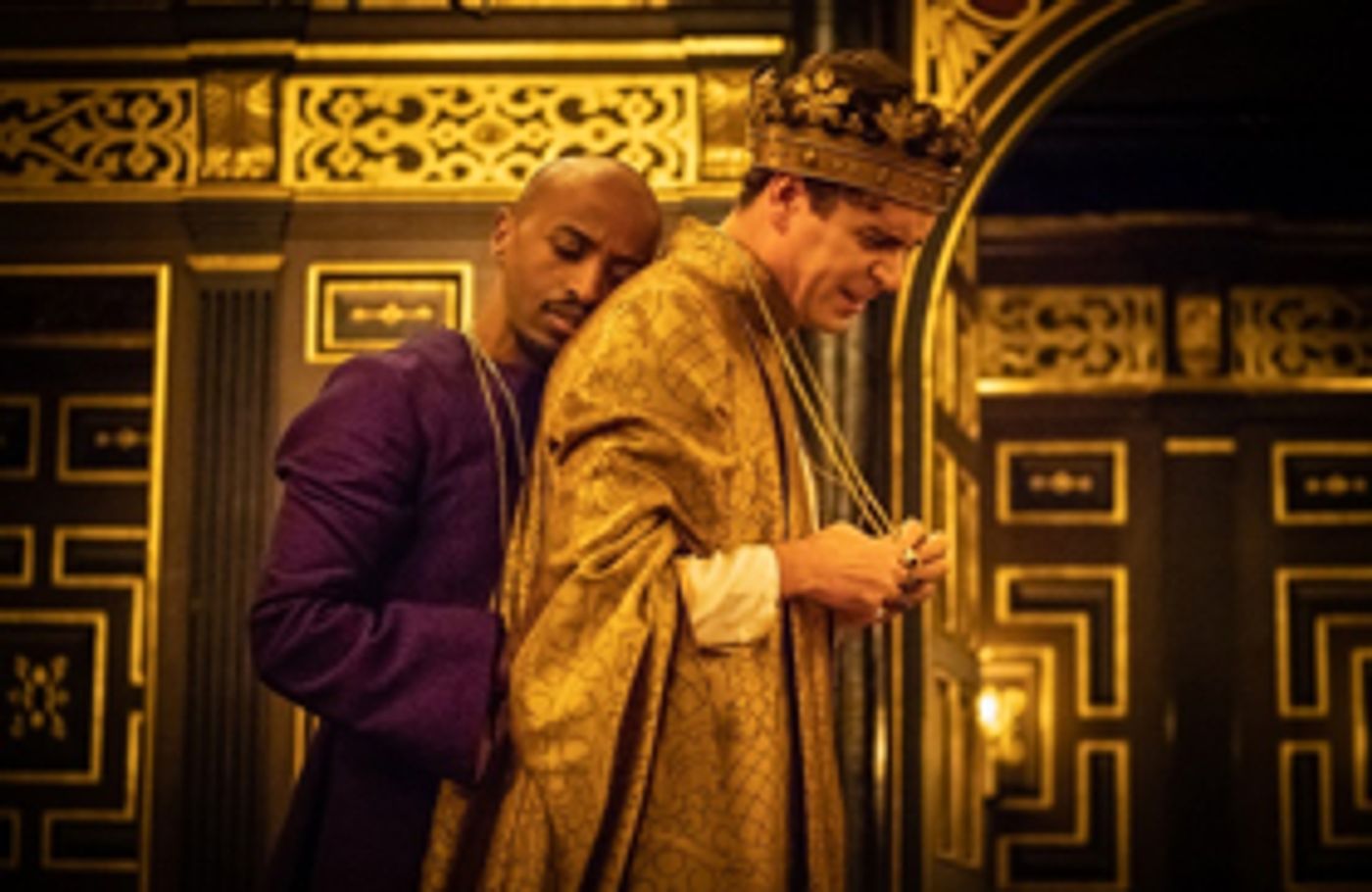Review: EDWARD II, Sam Wanamaker Playhouse

Christopher Marlowe's Edward II is one ![]() of the earliest English history plays, and tells the story of the title character, his infatuation with his favourites and the dissent of his disapproving peers. It is a tragedy, replete with violence, gore and death.
of the earliest English history plays, and tells the story of the title character, his infatuation with his favourites and the dissent of his disapproving peers. It is a tragedy, replete with violence, gore and death.
Nick Bagnall's production at the Sam Wanamaker Playhouse is decadent and intense. The design by Jessica Worrall features rich colours and bejewelled costumes. The standout pieces are the King's flowing cape and the Bishop of Coventry's spectacular gloves.
Despite being a tragedy overall, and featuring some truly horrific acts, Bagnall's production does well to bring Marlowe's humour to the fore. The audience were made to laugh out loud regularly as the lines were subtly but comically delivered.
This aspect was particularly commendable as often, in Early Modern plays, the missed opportunities for humour scream out in performances. As the play is so dark, the chance to have a laugh keeps the audience on side. The poetry of Marlowe's language does not go unnoticed as the rhyme and iambic pentameter are handled sensitively and effectively; there if you look for it, but not glaringly obvious.
The passion of the performers carries the piece forwards. From the moment the cast step on stage, they hook the audience with unblinking eyes and ethereal voices. Richard Bremmer is a commanding figure throughout, but especially when he takes centre stage in the opening sequence.
Richard Cant makes for a sassy Earl with a great breadth of facial expressions. The gender-blind casting is particularly effective in the case of Polly Frame, whose skilled performance draws the audience to the Earl of Kent as she portrays the subtleties of his inner conflict. Katie West gives a heart-wrenching Queen Isabelle, stoic yet sensitive.
Unfortunately, Annette Badland overacts a little at points, and Sanchia McCormack makes for a better Earl of Warwick than Sir John of Hainault. The lisping speech seems like a cheap laugh alongside the other comic moments in the play.
The three standout performances come from Beru Tessemsa, Tom Stuart and Colin Ryan. Although it's a little odd that Tessema is double cast, with Gaviston being so important to the narrative, his opening address is charming. He grabs the audience from the start with his infectious energy. His commentary on the other characters sets the tone for the play.
It's also a little confusing having Ryan in so many roles, but two of the strongest moments of the whole play are him being separated from King Edward as Spencer, and his coronation and the fallout as Prince Edward. He makes for a believable 15-year-old in the role too.
The protagonist has been well cast with Stuart, whose intense emotion and rapid downfall are very moving. His vulnerability, as a result of his depth of feeling, gives the play an added dimension. The scene of his death will stay with audiences for a long time afterwards.
One area in which the play falls down is the attention to detail. The intimacy of the venue means the audience can see everything, and the visible tattoos, zips and pockets, as well as obviously dyed hair, do take away somewhat from the transporting piece Bagnall has created.
A lot of the stage combat also suffers because of the proximity of the audience to the stage. It becomes a little less convincing on close inspection. However, Kevin McCurdy has put together the sword fighting sequences well and King Edward's death has a great impact.
Acoustics in the small space are brilliant and help create an electric atmosphere. The live music, under the direction of Rob Millett, is beautiful but, at points, the background soundscape is a little off-putting, with sounds being created that are almost robotic.
The homoeroticism is not depicted as homosexuality "back then". In fact, the King's relationships with his favourites are no different to that with his wife. The disapproval of other characters on stage is at the King's open displays of emotion rather than his choice of lovers. The play is not trying to make a statement about gender or sexuality, it is merely part of the story we are being told and the world that has been created.
This production, with its nudity, violence and upsetting scenes, is not for the fainthearted. However, it is not gratuitous. The play is an excellent example of Early Modern work and Bagnall's vision is complete and compelling.
Edward II at the Sam Wanamaker Playhouse until 20 April
Photo credit: Marc Brenner
Reader Reviews
Videos

